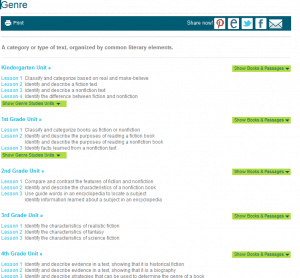Common Core Reading Lessons: Genre

A category or type of text, organized by common literary elements.
Genre Lessons - Covers kindergarten through sixth grade. Examples: Identify the difference between fiction and nonfiction. Identify facts learned from a nonfiction text. Use guide words in an encyclopedia to locate a subject. Identify the characteristics of science fiction. Identify and describe evidence in a text, showing that it is a biography.
Vocabulary Acquisition and Use
CCSS.ELA-Literacy.L.K.5 With guidance and support from adults, explore word relationships and nuances in word meanings.
CCSS.ELA-Literacy.L.K.5a Sort common objects into categories (e.g., shapes, foods) to gain a sense of the concepts the categories represent.
Key Ideas and Details
CCSS.ELA-Literacy.RI.1.1 Ask and answer questions about key details in a text.
CCSS.ELA-Literacy.RI.1.2 Identify the main topic and retell key details of a text.
Craft and Structure
CCSS.ELA-Literacy.RI.1.6 Distinguish between information provided by pictures or other illustrations and information provided by the words in a text.
Integration of Knowledge and Ideas
CCSS.ELA-Literacy.RI.1.7 Use the illustrations and details in a text to describe its key ideas.
CCSS.ELA-Literacy.RI.1.8 Identify the reasons an author gives to support points in a text.
Key Ideas and Details
CCSS.ELA-Literacy.RI.2.1 Ask and answer such questions as who, what, where, when, why, and how to demonstrate understanding of key details in a text.
CCSS.ELA-Literacy.RI.2.2 Identify the main topic of a multiparagraph text as well as the focus of specific paragraphs within the text.
Craft and Structure
CCSS.ELA-Literacy.RI.2.4 Determine the meaning of words and phrases in a text relevant to a grade 2 topic or subject area.
Integration of Knowledge and Ideas
CCSS.ELA-Literacy.RI.2.7 Explain how specific images (e.g., a diagram showing how a machine works) contribute to and clarify a text.
CCSS.ELA-Literacy.RI.2.8 Describe how reasons support specific points the author makes in a text.
Range of Reading and Level of Text Complexity
CCSS.ELA-Literacy.RI.2.10 By the end of year, read and comprehend informational texts, including history/social studies, science, and technical texts, in the grades 2-3 text complexity band proficiently, with scaffolding as needed at the high end of the range.
Research to Build and Present Knowledge
CCSS.ELA-Literacy.W.2.8 Recall information from experiences or gather information from provided sources to answer a question.
Comprehension and Collaboration
CCSS.ELA-Literacy.SL.2.1 Participate in collaborative conversations with diverse partners about grade 2 topics and texts with peers and adults in small and larger groups.
CCSS.ELA-Literacy.SL.2.1c Ask for clarification and further explanation as needed about the topics and texts under discussion.
CCSS.ELA-Literacy.SL.2.2 Recount or describe key ideas or details from a text read aloud or information presented orally or through other media.
Vocabulary Acquisition and Use
CCSS.ELA-Literacy.L.2.4 Determine or clarify the meaning of unknown and multiple-meaning words and phrases based on grade 2 reading and content, choosing flexibly from an array of strategies.
CCSS.ELA-Literacy.L.2.4a Use sentence-level context as a clue to the meaning of a word or phrase.
CCSS.ELA-Literacy.L.2.5 Demonstrate understanding of word relationships and nuances in word meanings.
CCSS.ELA-Literacy.L.2.5a Identify real-life connections between words and their use (e.g., describe foods that are spicy or juicy).
Key Ideas and Details
CCSS.ELA-Literacy.RL.3.1 Ask and answer questions to demonstrate understanding of a text, referring explicitly to the text as the basis for the answers.
CCSS.ELA-Literacy.RL.3.3 Describe characters in a story (e.g., their traits, motivations, or feelings) and explain how their actions contribute to the sequence of events.
Craft and Structure
CCSS.ELA-Literacy.RL.3.5 Refer to parts of stories, dramas, and poems when writing or speaking about a text, using terms such as chapter, scene, and stanza; describe how each successive part builds on earlier sections.
Range of Reading and Level of Text Complexity
CCSS.ELA-Literacy.RL.3.10 By the end of the year, read and comprehend literature, including stories, dramas, and poetry, at the high end of the grades 2-3 text complexity band independently and proficiently.
Fluency
CCSS.ELA-Literacy.RF.3.4 Read with sufficient accuracy and fluency to support comprehension.
CCSS.ELA-Literacy.RF.3.4a Read on-level text with purpose and understanding.
CCSS.ELA-Literacy.RF.3.4c Use context to confirm or self-correct word recognition and understanding, rereading as necessary.
Vocabulary Acquisition and Use
CCSS.ELA-Literacy.L.3.4 Determine or clarify the meaning of unknown and multiple-meaning word and phrases based on grade 3 reading and content, choosing flexibly from a range of strategies.
CCSS.ELA-Literacy.L.3.4a Use sentence-level context as a clue to the meaning of a word or phrase.
CCSS.ELA-Literacy.L.3.5 Demonstrate understanding of word relationships and nuances in word meanings.
CCSS.ELA-Literacy.L.3.5b Identify real-life connections between words and their use (e.g., describe people who are friendly or helpful).
CCSS.ELA-Literacy.L.3.6 Acquire and use accurately grade-appropriate conversational, general academic, and domain-specific words and phrases, including those that signal spatial and temporal relationships (e.g., After dinner that night we went looking for them).
Key Ideas and Details
CCSS.ELA-Literacy.RL.4.1 Refer to details and examples in a text when explaining what the text says explicitly and when drawing inferences from the text.
CCSS.ELA-Literacy.RL.4.2 Determine a theme of a story, drama, or poem from details in the text; summarize the text.
CCSS.ELA-Literacy.RL.4.3 Describe in depth a character, setting, or event in a story or drama, drawing on specific details in the text (e.g., a character's thoughts, words, or actions).
Research to Build and Present Knowledge
CCSS.ELA-Literacy.W.4.9 Draw evidence from literary or informational texts to support analysis, reflection, and research.
CCSS.ELA-Literacy.W.4.9a Apply grade 4 reading standards to literature (e.g., ''Describe in depth a character, setting, or event in a story or drama, drawing on specific details in the text [e.g., a character's thoughts, words, or actions].'').